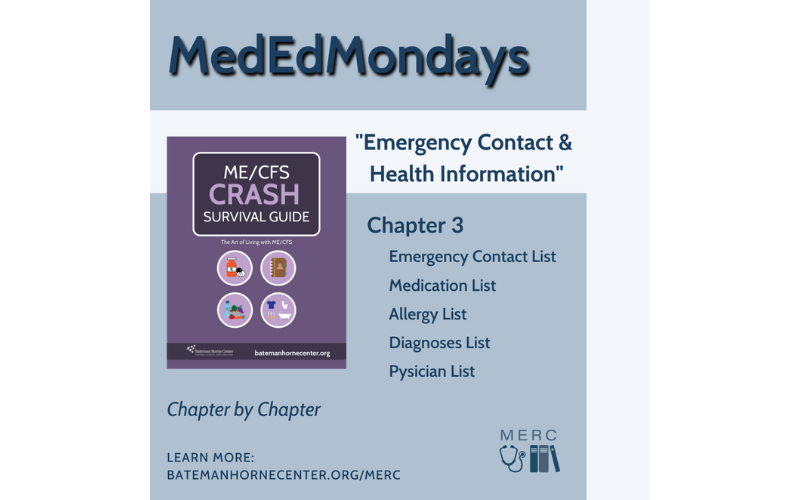This blog post covers the third chapter of the ME/CFS Crash Survival Guide. The information provided can also apply to individuals with long COVID and other multi-system chronic complex illnesses that have a PEM component.
Click here to download the entire guidebook.
Chapter 3: Emergency Contact & Health Information
Meeting the body’s basic and critical needs during a crash is essential to recovery. This starts with setting up assurances that someone can check on you and is informed about your medical needs.
Contact someone in your household or on your emergency care list (family member, neighbor, co-worker, friend, etc.) to let them know you are experiencing a crash and may need help. For those living alone, planning ahead may include utilizing a medical alert system to summon for help when needed.
-
- Keep a list of your emergency contacts in your bedside Crash Care Kit, on your refrigerator, and in your purse or wallet.
- Include the contacts’ name, phone number, and relation to you.
- Program ICE (in case of emergency) contacts into your phone. Emergency personnel will look for these names first.
- Have these individuals labeled with ICE in front of their name and keep them in your “favorites” section for ease of access.
- Consider creating a pre-formed text group that can be quickly accessed to ease memory recall. These may be the same or different than your ICE contacts.
- Indicate their relation to you in one of the contact fields.
Keep your medical and physician contact lists accessible to you, your support network, and emergency personnel. Consider printing a copy of your patient summary from your last visit with your ME/CFS provider and have it available for reference. The following downloadable lists, which can be typed in and printed, are located on the ME/CFS Crash Survival Guidebook webpage.
Medication list
- Include current medications with date, time taken, and reason for taking.
- Include rescue and PRN (as needed) medications.
- Discontinued medications list.
- This list is helpful for your tracking purposes and for providers to know what you have tried, what has/hasn’t worked, and why.
Allergy list
- List allergies, symptoms, interventions that help, and indicate if the reaction is dangerous (anaphylaxis) or is an allergy/intolerance.
Diagnoses list
- List your known diagnoses, how long you have had them, and the provider that diagnosed you (if known).
- If not yet diagnosed, but is suspected, list these and make a clear distinction that it is not a confirmed diagnosis.
Physician list
- List your doctors’ names with specialty(ies), phone number(s), and why you see them.
This blog post covers the third chapter of the ME/CFS Crash Survival Guide. Click here to download the entire guidebook.
The information provided can also apply to individuals with long COVID and other multi-system chronic complex illnesses that have a PEM component.
Bateman Horne Center and Open Medicine Foundation are partnering to educate
medical professionals about multi-system chronic complex diseases.
If you find this content helpful support our work by donating today!

 Lucinda Bateman, MD, is a renowned clinician, researcher, and educator. Her Johns Hopkins University Medical School training instilled an approach to care that she has employed throughout her career - the patient comes first and the unknown or unexplained does not equate to a lack of proper and compassionate care. Since starting her own practice in 2000, she has served on six boards or committees, been the principal investigator for 45 studies, authored/coauthored 40 journal articles, served as adjunct instructor and adjunct assistant professor in the University of Utah Departments of Preventative Medicine, Internal Medicine, and Anesthesiology, and lectured around the world.
Lucinda Bateman, MD, is a renowned clinician, researcher, and educator. Her Johns Hopkins University Medical School training instilled an approach to care that she has employed throughout her career - the patient comes first and the unknown or unexplained does not equate to a lack of proper and compassionate care. Since starting her own practice in 2000, she has served on six boards or committees, been the principal investigator for 45 studies, authored/coauthored 40 journal articles, served as adjunct instructor and adjunct assistant professor in the University of Utah Departments of Preventative Medicine, Internal Medicine, and Anesthesiology, and lectured around the world.